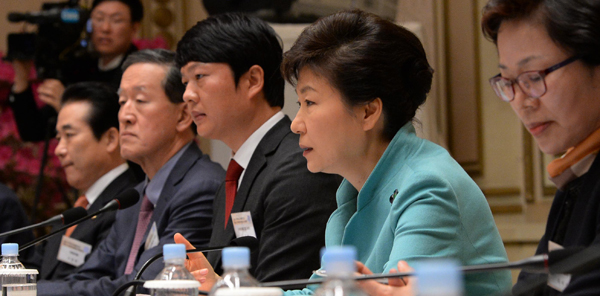A new era of exports

President Park Geun-hye makes a speech at a meeting aimed at promoting trade and investment at the Blue House last month. [Joint Press Corps]

Kim Young-hak
Exports have been the main economic driver for the country, allowing it to get through many difficult times. But annual growth has plateaued since topping $1 trillion and exports are no longer translating into the kind of stimulation in domestic demand that leads to more hiring. The size of our trade and economy is getting bigger, but jobs have become scarcer for young job-seekers. This is leading to a clash between the older and younger generations in the thinning job market.
The economy no longer can run on an expansion model. It must aspire to have balanced growth in quality as well as in sheer numbers.
Exports hitherto have been primarily the bailiwick of large manufactures. Large companies were accountable for 67 percent of overseas shipments last year. Thanks to their centrifugal strength and aptitude, large companies have boldly ventured overseas and helped turn the country into a trading powerhouse. To reach a goal of $2 trillion in annual trade, small and midsize enterprises should start playing a much more significant role.
There are more than 3.23 million small and midsize companies in Korea. Only 8,700 - or 2.7 percent - export. Companies that shipped more than $1 million worth of goods in a year totaled around 22,000. In Britain, small and midsize traders account for 11 percent of exports. The share is 10.9 percent in Germany and 9.4 percent in the Netherlands. Small companies are well represented in balanced economies across the globe, contributing to bringing revenue back to their domestic economies and creating new jobs. Of the 1,500 major German exporters, 90 percent are either small or midsize. Thanks to their strong contributions, Germany did not falter when most advanced economies were hit by the U.S.-triggered global financial crisis starting in 2008. We can envy Germany but also learn from it.
More than 3.23 million small and midsize companies employ about 12.63 million people, accounting for 86.9 percent of the total number of workers on corporate payrolls. The employment share of small and midsize companies in European Union countries hovers around 66.7 percent. Korea’s small and midsize companies could play a crucial role in enlarging the job market. But they are mostly small domestic players. Seeking out strong small and midsize companies and helping them with overseas ventures could realign the Korean economy to a more balanced structure and pave the way toward a $2 trillion trade goal. It is a way for both large and smaller enterprises to grow in sync and provide traction for the economy in its march toward the next half-century.
At a trade and investment promotion conference, the government unveiled plans to foster 100,000 exporters from the small and midsize corporate category. To make the plan work, the government must have a broad understanding of their businesses and provide tailored support. Other institutions should also chip in. Financing companies and small and midsize businesses should work in partnership. Funding should not end in one-off grants but must be sustained through secure and practical financial arrangements. The Korea Trade Insurance Corporation last year signed agreements with 31 local governments and umbrella institutions to jointly design a comprehensive growth program for small exporters.
There is a saying by Confucius that one should seek eagerly and think practically. Support for small and midsize exporters should not stop at rhetoric. The government should visit small and midsize companies with aspirations to export and discover their needs. They must see for themselves how these companies are working toward their dreams. Big companies should cooperate to accelerate their transformations.
Translation by the Korea JoongAng Daily staff.
JoongAng Sunday, April 13, Page 30
*The author is the president of the Korea Trade Insurance Corporation and former vice minister of the Ministry of Trade, Industry and Energy.
By Kim Young-hak










with the Korea JoongAng Daily
To write comments, please log in to one of the accounts.
Standards Board Policy (0/250자)